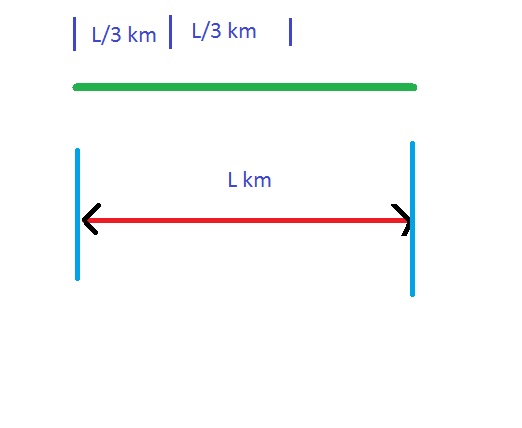
Assume total length=#L kilometers#
Average velocity=Total distance up to#2/3#part /Time up to #2/3#part
#V_(avg)=(d_1+d_2)/(t_1+t_2)# #" "color(blue)((1))#
where,
#v_1#=velocity up to #1/3#rd part =20 km/hr,
#t_1#=time taken for car up to #(1/3)^(rd)# part,
#d_1#=distance up to #(1/3)^(rd)# part =#L/3#kilometers
#v_2#=velocity from #(1/3)^(rd)#part to #(2/3)^(rd)#part=60km/hr,
#t_2#=time taken from #(1/3)^(rd)#part to #(2/3)^(rd)#part,
#d_2#=distance from #(1/3)^(rd)#part to #(2/3)^(rd)#part= #L/3#km.
For first #1/3#rd part:
given that,
#v_1=20(km)/(hr)#
#d_1/t_1=20#km/hr [since from velocity definition]
#L/3/t_1=20#km/hr [since#d_1=L/3#]
#L/(t_1)=60#km/hr #" "color(blue)((2))#
from #(1/3)^(rd)#part to #(2/3)^(rd)#part:
given that,
#v_2=60 #km/hr,
#d_2/t_2#=60km/hr,
#L/3/t_2#=60km/hr [since #d_2=L/3km#]
#L/(3t_2)#=60km/hr #" "color(blue)((3))#
Divide equation(2) with equation(1),
We get #t_1=3t_2# #" "color(blue)((4))#
From equation(1),
#V_(avg)=(d_1+d_2)/(t_1+t_2)#
#V_(avg)=((L/3)+(L/3))/(3(t_2)+t_2)#[since from equation(4)]
#V_(avg)=1/2*(L/(3t_2))#
#V_(avg)=1/2*(60(km)/(hr))#[since from equation (3)]
#V_(avg)=30(km)/(hr)#
A car cover 1/3 distance with speed 20km/hr and 2/3 with 60km/hr. average speed is #" "color(blue)30# km/hr.


